- 1Marine Mammal and Marine Bioacoustics Laboratory, Institute of Deep-sea Science and Engineering, Chinese Academy of Sciences, Sanya, China
- 2Department of Marine Animal Conservation and Public Engagement, Stazione Zoologica Anton Dohrn, Naples, Italy
- 3National Institute of Water and Atmospheric Research, Coasts and Oceans, Wellington, New Zealand
The distribution of Indo-Pacific finless porpoise (IPFP, Neophocaena phocaenoides) around the Hainan Island (China) is unknown, but evidences for a resident population have recently emerged. Passive acoustic data were collected from 10 locations along the south-west area of the island using static sensors (about 200 km of coastline), over a total period of 476 days from 25th February 2018 to 16th June 2019 (154,884 5-min recordings). A supervised machine learning technique was used to classify IPFP clicks and acoustic features were measured for 2,654 short-narrowband pulses detected within 47 days across the 10 sites. Detections were verified by a trained operator using spectrogram analysis and the detection range of the clicks was estimated using a Transmission Loss (TL) model. The animals were not detected at all locations and the site with the highest number of detections was characterized by low levels of ambient noise, abundance of soniferous fishes and the presence of another marine mammal species, the Indo-Pacific humpback dolphin (Sousa chinensis). The northernmost region had no detections and only two recorded files containing IPFP clicks were found at the two nearby locations (one file each). In general, the low number of detections in the study area are most likely a result of the limited detection range (about 200 m) of IPFP echolocation signals. This is a nationally protected species and the Hainan population is increasingly subject to many threats. The large-scale and long-term monitoring approach provides information regarding the spatial acoustic occurrence of this vulnerable, nearshore and small-size cetacean.
1 Introduction
The Indo-pacific finless porpoise (IPFP, Neophocaena phocaenoides) is one of the seven species belonging to the family Phocoenidea. This species inhabits the coastal waters of many Asian countries including China, Korea, Japan, Indonesia, Malaysia and Bangladesh (Reeves et al., 1997; Kasuya 1999) and its status is classified as “Vulnerable” by the IUCN Red List (Wang and Reeves, 2017), making it a high priority for conservation. These animals are highly vulnerable to human impacts, especially fisheries bycatch (Jefferson et al., 2020).
The distribution of finless porpoises around Hainan Island (China) is unknown, but evidences for a resident population have recently emerged (Liu et al., 2018; Caruso et al., 2020a; Liu et al., 2022a). A comprehensive review study revealed 12 stranding events of finless porpoises both on the north and south sides of the island between 1978 and 2016 (Liu et al., 2018). A fisherman survey also revealed that finless porpoises are among the three species more frequently caught as bycatch around Hainan Island (Liu et al., 2016), and a local knowledge survey showed that this species is regularly sighted in all coastal areas of the island (Liu et al., 2019). The survey also revealed the fishermen perception that the abundance and frequency of species sightings have been decreasing in recent years (Liu et al., 2016). Recent recordings of free ranging IPFPs were also obtained during a series of combined visual and acoustics surveys (Caruso et al., 2020a).
The coastal waters around Hainan—that potentially represent good habitat for IPFPs—are in a region of rapid human population growth (between 2001 and 2020 the population grew substantially from 0.796 to 1.012 million people), economic development (coastal construction and touristic business), and increasing offshore human activities (mineral resource exploration and exploitation, and fisheries) (Wang and Wall, 2007; Marcotte et al., 2015). Human activities pose a risk on wild cetacean populations and could determine a general decline in cetacean abundance (Taylor et al., 2007; Schipper et al., 2008). Some of the key factors in determining whether a population is impacted or not by human activities include knowledge of population trends, occurrence and distribution, and the capacity to monitor the population over time.
Monitoring this species in the natural environment is extremely challenging. Finless porpoise, due to its small body size (approximately 1.5 m length), no dorsal fin, and short (1–2 s) surfacing times, are very difficult to spot and count visually (Li et al., 2010). Additionally, variable weather conditions and different levels of experience among the observers can cause additional biases in the detection probabilities during visual surveys. Like other Phocoenidae, finless porpoises use Narrow Band High Frequency (NBHF) echolocation to forage and sense their environment (Li et al., 2010). Their echolocation signals recorded around Hong Kong showed peak frequencies around 142 kHz (with almost no energy below 100 kHz) and a mean pulse duration of 104 µs (Goold and Jefferson 2002). Akamatsu et al. (2001) showed that the acoustic detection is an effective method for field surveys of small cetaceans.
Passive Acoustic Monitoring (PAM) have been extensively used for monitoring wild cetacean populations (Giorli et al., 2016; Caruso et al., 2017; Giorli et al., 2019) and are a cost-effective solution to collect data over large areas (Caruso et al., 2020a). Our study aimed at collecting data to monitor the occurrence of finless porpoises over long time periods in Hainan Island using a large-scale network of passive acoustic sensors moored in very shallow waters (10–16 m water depth).
2 Methods
2.1 Study area and acoustic data collection
The study was carried out in the southwestern waters of Hainan Island and passive acoustic data was collected from 10 locations (Figure 1). Each station consisted of a metal frame anchored to the ocean bottom and equipped with a single channel SoundTrap recorder (ST300 HF, Ocean Instruments Ltd., New Zealand). The SoundTrap recorder has a linear frequency response (±3 dB re 1 µPa) between 20 Hz and 150 kHz, self-noise levels below the general noise levels at sea-state 0 in the bandwidth 100 Hz–2 kHz and a sensitivity of −203 dB re V/mPa with the high gain setting used in our study. The maximum peak-to-peak sound pressure level measurable before saturating the system was 172 dB re 1 µPa. A recording duty cycle of 5 min every 30 min (16.6%) was used, with a sampling frequency of 288 kHz. In total, the recorders operated over a total period of 476 days from 25th February 2018 to 16th June 2019, acquiring 154,884 five-minute recordings (wav), a dataset of 12,907 h constituting about 26.8 TB of audio files (Table 1). The PAM sampling sites were not progressively named numerically from south to north because platform #0 was previously deployed during another study (Dong et al., 2017).
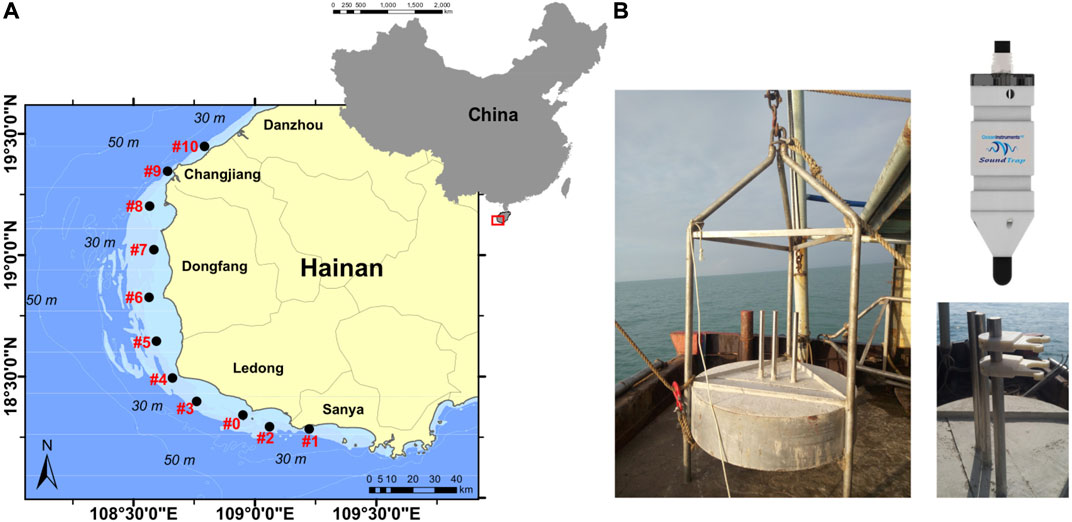
FIGURE 1. PAM sites and platforms. (A) Map of the locations of the PAM sites. (B) Image of a PAM platform. The recorder was fixed on a stainless steel column at the center of each platform.
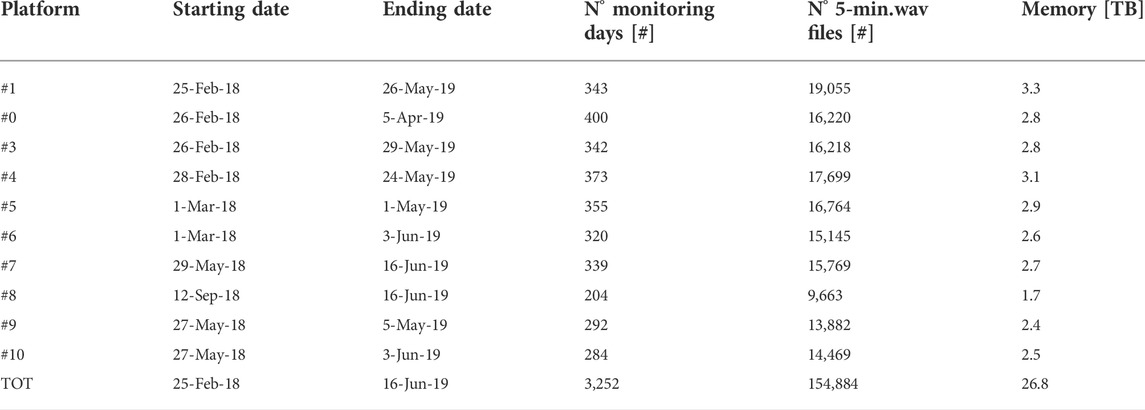
TABLE 1. Recording Platforms. Table reporting data acquisition information (monitoring period, number of files, storage). The frame P#2 was lost during the study.
2.2 Acoustic data analysis
The methods described by Caruso et al. (2020a) were used to detect and classify IPFP echolocation signals (Figure 4A). The detection process is based on a MATLAB (MathWorks, Natick, MA, United States) custom routine used to extract and measure various signal parameters of each echolocation click detected in the dataset (Caruso et al., 2017). The algorithm first applies a 4th order Butterworth high-pass filter with cut-off frequency of 3 kHz. A Teager-Kaiser operator is then used to detect the broadband echolocation click with an amplitude that is above an adaptive threshold level (Caruso et al. (2017). Each echolocation signal is extracted in a time window of 1.8 ms centered at the peak of the click. All parameters were measured as described in Caruso et al. (2020a).
Information on the position of the source was not considered, and therefore on the direction of origin and the distance of the recorded animals. The signal parameters measured for each echolocation click are 1) Pulse duration (d) [µs]; 2) Peak frequency (fp) [Hz]; 3) Centroid frequency (fc) [kHz]; 4) −3 dB Bandwidth [kHz] (BW−3dB); 5) Root-Mean Square Bandwidth (BWRMS); 6) QRMS [kHz]; 7) Number of zero crossing (Zc) [#]; 8) Inter-click interval (ICI) [ms]. A supervised machine learning algorithm (Cubic SVM) was trained to automatically classify echolocation clicks of finless porpoises from the different types of short-broadband pulses recorded in Hainan waters (Caruso et al., 2020a). A trained operator analyzed the waveform and spectrogram of the classified signals using the software Raven Lite (Bioacoustics Research Program, Cornell Lab of Ornithology). After click classification, the peak sound pressure level (SPLpk, expressed in dB re 1 µPa) in the time window of the pulse duration was measured. The variability of signal features is illustrated using boxplots and described as mean ± standard deviation.
The detection range of free-ranging IPFPs was estimated by modeling the attenuation of their echolocation clicks, as well as measuring the ambient noise levels at the location of the recordings (Caruso et al., 2020a). The Power Spectral Density (PSD) in each acoustic file was computed and the average PSDs (over the entire study period) at each location were computed. Previously recorded on-axis clicks of finless porpoises were used to compute the PSD of a click recorded at 1 m from a 13-element star-shaped array of hydrophones (Gong et al., 2019). Transmission Loss (TL) was modeled considering both geometrical spreading (spherical) and absorption using the formula:
for a series for ranges R between 10 and 300 m. The values of the absorption coefficient α was computed for each frequency point of the PSD from measurements of temperature, hydrostatic pressure, pH, and salinity (Ainslie and McColm, 1998) at a depth of 10 m. These measurements were collected at each station during the deployment operations using a portable YSI Professional Plus device (Ohio, United States) and a Hondex PS-7 portable Depth Sounder (Honda Electronics, Japan).
3 Results
3.1 Species distribution and detection range
In total, 2,654 short pulses were identified as clicks from IPFPs within 51 files (5-min recordings) across eight PAM sites (stations #9 and #10 had no detections). The spatial distribution of the species was evaluated across the PAM sites considering the number of files with click detections for each platform (Figure 2). Considering the low number of files with detections (0.03% of the total number), no further analyses on temporal distribution and acoustic activity (number of echolocation signals logged per file) have been done. Only one 5-min file contained clicks from IPFPs was reported at platforms #7 and #8 and the station with most detections was the #5 (N = 22), located in the south coast of the Dongfang region.
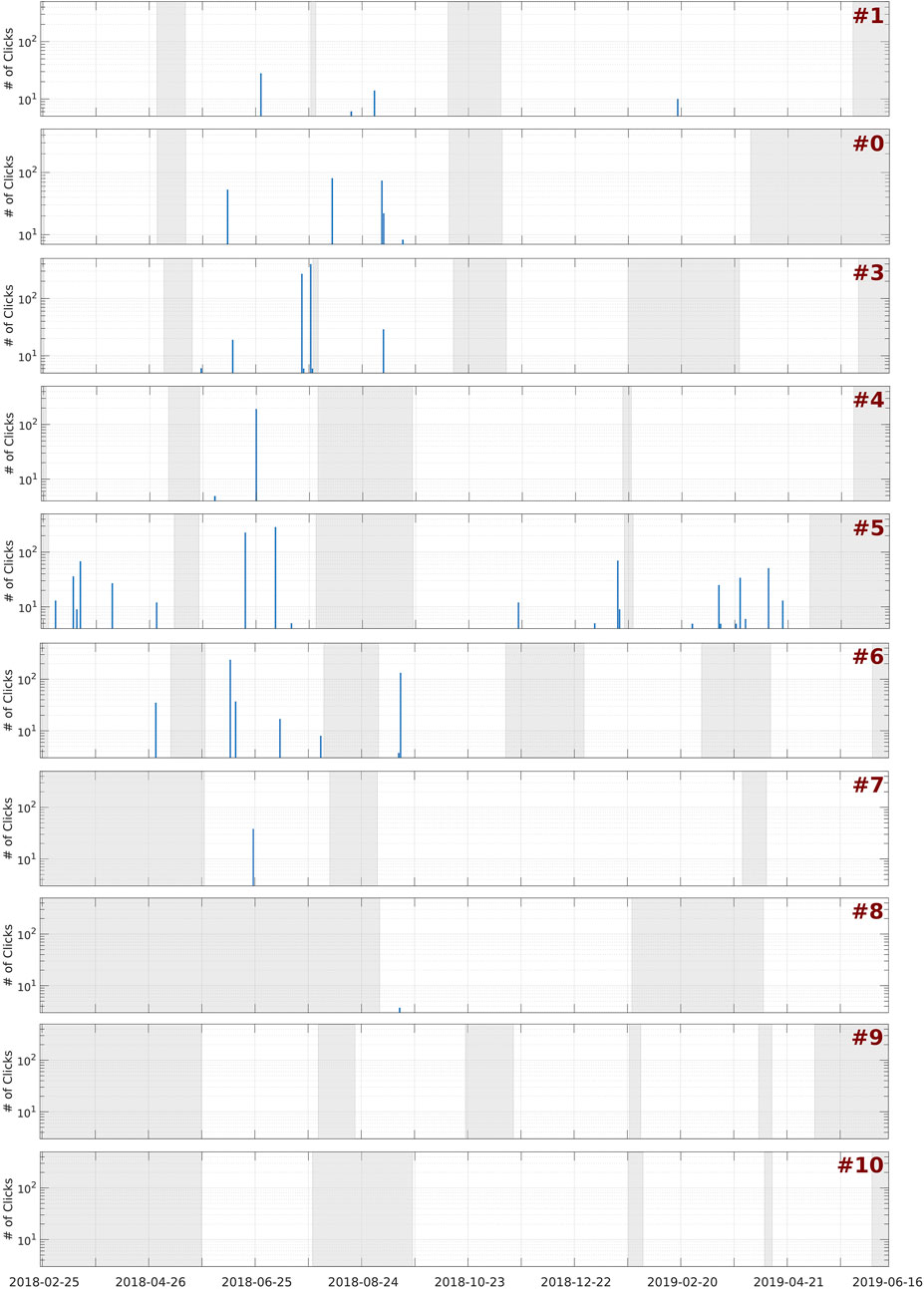
FIGURE 2. Spatio-temporal Distribution. Number of files per day with Indo-Pacific finless porpoise echolocation signals. The areas in gray represent periods of no data collection.
At a range of 200 m, in most of the stations the ambient noise level is higher than the levels of the echolocation signals of IPFP. At the shorter range of 100 m, the clicks can be detectable at all the PAM sites except for platform #7 (Figure 3).
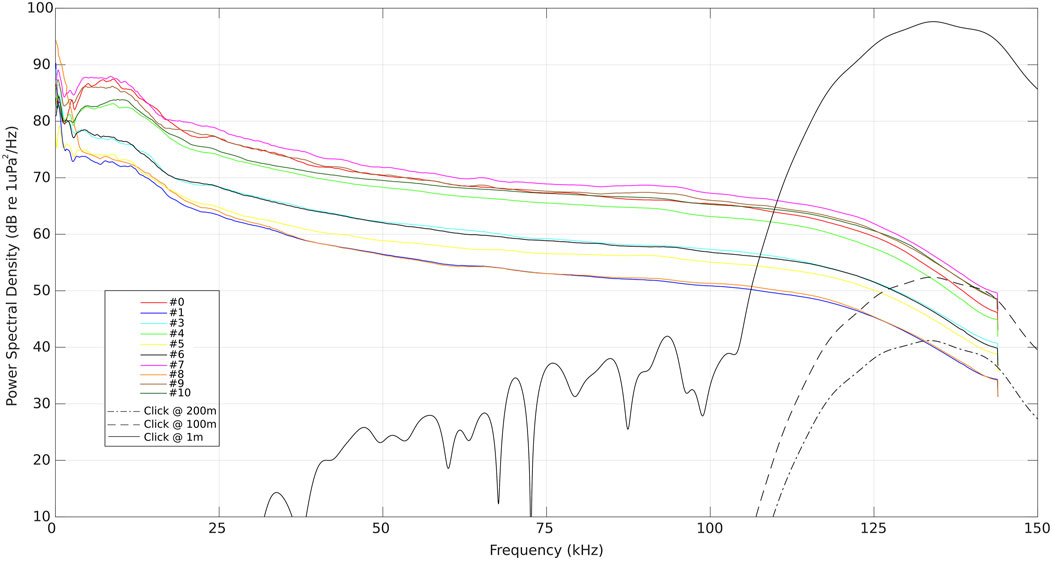
FIGURE 3. Modelled Detection Range. The average Power Spectral Densities (PSDs, dB re 1 µPa 2/Hz) measured for the files acquired by the seven platforms with detections of finless porpoises (different colors). The gray curve represents the PSD of a single click as Source Spectral Density (SSD, dB re 1 µPa/√Hz @ 1 m). The dotted lines show the received levels (RL) model of the click, respectively, at 100 and 200 m. The variation of the signal during propagation is shown in relation to the ambient noise recorded at the PAM sites.
3.2 Signal features
The signals classified as echolocation clicks of IPFPs showed a mean duration of 90 ± 23 µs(mean ± standard deviation, SD), a mean peak frequency of 123.6 ± 4.4 kHz (mean ± SD) and a mean centroid frequency of 130.7 ± 3.8 kHz (mean ± SD). The measured BWRMS was 16.7 ± 1.5 kHz (mean ± SD) and the BW−3dB was 15.5 ± 3.9 kHz (mean ± SD). The QRMS value of the detected signals was 8 ± 1 (mean ± SD). The number of zero crossing was 22 ± 4 # (mean ± SD) and the Inter-click intervals presents an average of 0.02 ± 0.9 s (mean ± SD) (Figure 4B). Finally, the mean SPLpk resulted 143 ± 4 dB re 1 µPa (Figure 4C).
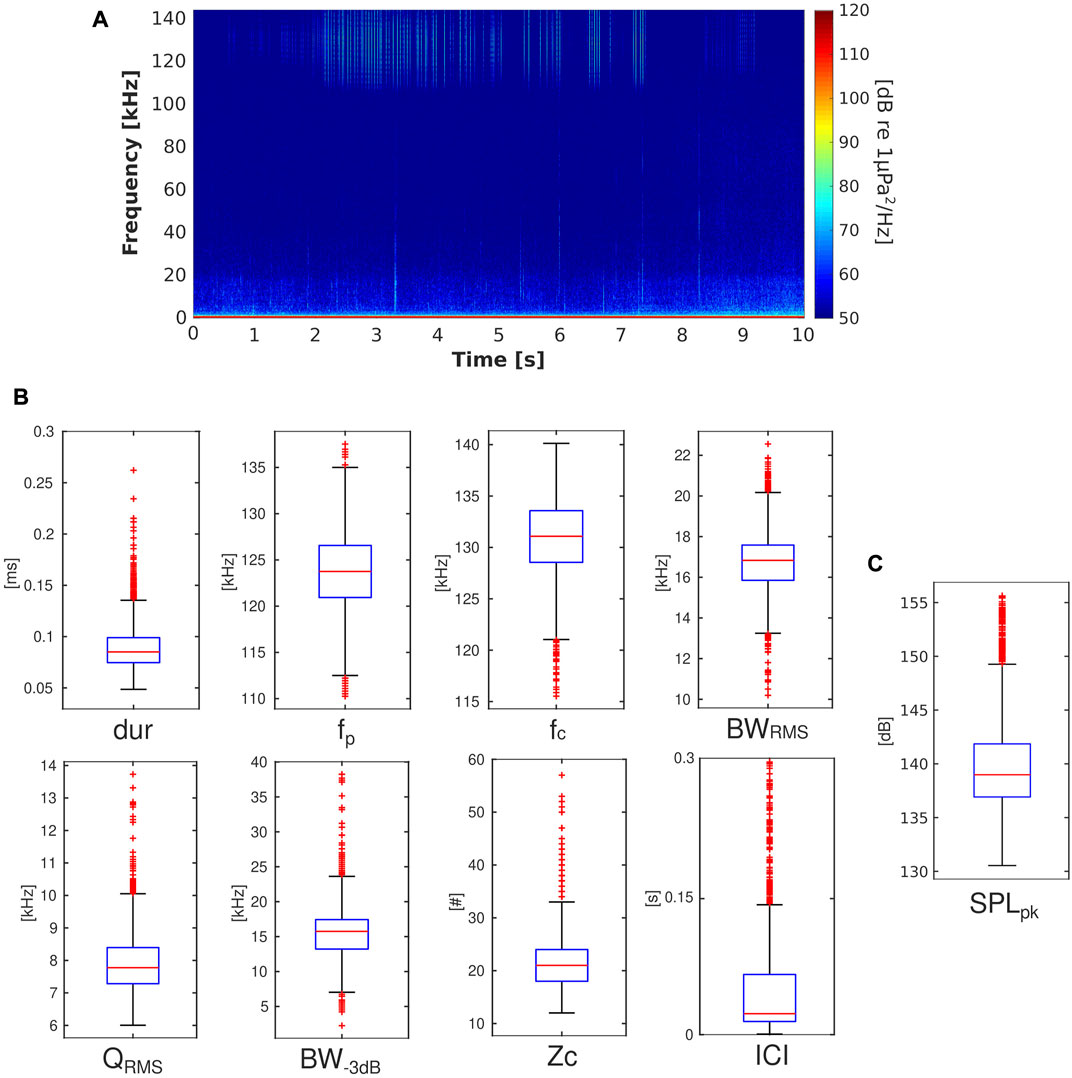
FIGURE 4. Click Features. (A) Spectrogram (nfft = 2048; overlap = 50; Hann window) of 10-s interval with high-frequency narrowband clicks from IPFP (above 100 kHz). (B) Boxplots showing the distribution of the parameters measured during classification (durations, peak frequency, centroid frequency, RMS Bandwidth, QRMS, −3 dB Bandwidth, Zero-crossing and Inter-Click Interval) of the 2,654 clicks detected. (C) Distribution of sound pressure level of signal peak (SPLpk, expressed in dB re 1 µPa) for the 2,654 clicks detected. In each box, the central mark indicates the median, and the bottom and top edges of the box indicate the 25th and 75th percentiles, respectively. Whiskers extend to the most extreme data points not considered outliers (1.5 x interquartile range), and outliers are plotted individually using the “+” symbol (in red).
4 Discussion
The IPFP is the most commonly stranded odontocetes in Hainan Island (Lin et al., 2019), and based on local ecological knowledge (LEK), its population seems to be in decline due to overfishing, water pollution, vessel collisions and bycatch on marine mammals (Liu et al., 2016, Liu et al., 2019). Knowing the spatio-temporal distribution and abundance of the species around the island will be essential to efficiently promote conservation actions. During visual surveys of marine mammals in the study area (Liu et al., 2022b), the main species reported was the Indo-Pacific humpback dolphin (Sousa chinenesis), then the Indo-Pacific finless porpoise (Neophocaena phocaenoides), and a single sighting was logged for both the Indo-Pacific bottlenose dolphin (Tursiops aduncus) and the false killer whale (Pseudorca crassidens).
IPFPs are mainly present in the western area of Hainan Island and specifically in the Dongfang region (Figure 1), according to different monitoring methodologies. The acoustic data analyzed in this study confirmed the information obtained by the questionnaire-based survey of local fishermen (Lin et al., 2019). Four sightings were also reported from 2014 to 2019 and all of them in coastal waters south of Dongfang (close to sites #4, #5 and #6) (Liu et al., 2022b). Moreover, Liu et al. (2016) reported during the fishermen interviews that a substantial proportion of informants in this area have eaten or sold marine mammal meat and the bycatch events were also higher in western coastal waters of the island. In general, the monitoring effort was not uniform among the study area (Liu et al., 2022b), and the PAM stations in the northernmost region (sites #7, #8, #9 and #10) acquired less data during the first 6 months of the study (Figure 2). Additionally, the low number of acoustic detections are most likely a result of the limited detection range of the finless porpoise echolocation signals (Figure 3).
Moreover, the highest number of clicks from Indo-Pacific humpback dolphins (IPHDs), in association with communication and feeding sounds, were also reported in the south area of Dongfang (Caruso et al., 2020b). No files were found in which clicks of IPHDs and IPFPs were recorded together. The site with most IPFP detections (site #5) was found to have a high number of sounds from soniferous fishes, the least number of anthropogenic noises and in general the lowest average of broadband sound pressure levels (Xu et al., 2020; Caruso et al., 2020b). Therefore, as described for IPHDs (Caruso et al., 2020b), the distribution of IPFPs seems to be influenced by low levels of ambient noise and anthropogenic activities, and abundance of possible prey. The variation of soundscape resulted an important feature influencing the distribution of both these near-shore and small-size cetaceans and future research will have to investigate their habitat overlap and if there is any competition for the use of the available resources.
IPFP occurs year-round also in waters of southern and eastern Hong Kong. Goold and Jefferson (2002) recorded the acoustic signals of this species for the first time and described the clicks to be narrowband and high-frequency ultrasonic pulses (Goold and Jefferson 2002). In this study, we confirmed that the echolocation clicks from the IPFP have no energy below 100 kHz (Figure 4A), and all the short pulses with QRMS bigger than 6 and peak frequency higher than 110 kHz are echolocation clicks of IPFPs (Caruso et al., 2020a). Akamatsu et al. (2001) detected thousands of ultrasonic pulses emitted by Yangtze finless porpoise (N. asiaeorientalis), with dominant frequencies higher than 100 kHz, a local peak at 140 kHz and local minimum at 125 kHz, and an average value of the maximum SPLs corresponding with visual detection at 100 m (137.4 dB SPLp–p re 1 µPa). Regarding the detection range of the acoustic sensors used in this study (Figure 3), the values are similar to the results found for the Yangtze finless porpoise (reliably detected within 275 m) (Akamatsu et al., 2001). The differences detected in this study could depend on the data acquisition system, the analysis of off-axis clicks, the acoustic behavior of porpoises in the marine environment (compared to a freshwater river), the different levels of ambient noise and, of course, the different species investigated.
The use of PAM has expanded our survey ability in the study area, acquiring data simultaneously at ten locations and advancing field observations. In the waters around the Hainan Island, marine mammals are facing several threats (e.g., overfishing, environmental pollution, habitat degradation) and currently expansions of coastal development seem to be one of the main concerns (Caruso et al., 2020a). Lin et al. (2019) showed that regulating coastal fisheries in the Pearl River Delta region is an effective management tool in securing the long-term persistence of the finless porpoises (Lin et al., 2019). Therefore, the increase of human activities could potentially affect Hainan’s population and a conservation framework for coastal cetaceans around the island is urgently needed, considering the possible establishment of Marine Protected Areas (MPAs) in locations where the animals occur more frequently and in relatively high abundance. In particular, mitigation actions should be focused on a reduction of the effects of fishing activities and coastal development, for a species that is particularly vulnerable to both these threats. Moreover, it is very important to increase community-based education initiatives to raise public awareness about marine mammal conservation, and to improve the enforcement of wildlife protection laws around the Hainan province. Regional community-based conservation actions could be promoted through environmental education, ecosystem management and a sustainable development based on the strict collaboration between governance, scientists, fishermen, tourism and local communities.
Data availability statement
The raw data supporting the conclusions of this article will be made available by the authors, without undue reservation.
Ethics statement
The data collection and use protocols were approved by the Institute of Deep-sea Science and Engineering, Chinese Academy of Sciences, with the ethics approval code IDSSESYLL-MMMBL-01.
Author contributions
FC, GG, LD, and SL conceived the study. FC, LD, LZ, MlL, and MmM carried out the platform deployments and data collection. FC designed the data analysis protocol and the classification process. FC, GG, LD and LZ analyzed the acoustic data. All authors reviewed the manuscript and provided ideas, materials, and analysis tools.
Funding
This study was financially supported by the National Natural Science Foundation of China (Grant Nos. 41306169 and 41422604), the “One Belt and One Road” Science and Technology Cooperation Special Program of the International Partnership Program of the Chinese Academy of Sciences (Grant No. 183446KYSB20200016), and the Key Deployment Project of Center for Ocean Mega-Science of the Chinese Academy of Sciences (Grant No. COMS 2020Q15). This study was performed under an Ethical Statement of the Institute of Deep-sea Science and Engineering, Chinese Academy of Sciences, with the approved number of IDSSE-SYLL-MMMBL-01.
Acknowledgments
We are grateful to all the colleagues and students who helped us or provided us with logistical support in data collection and curation. FC would like to thank the President’s International Fellowship Initiative (PIFI) of the Chinese Academy of Sciences.
Conflict of interest
The authors declare that the research was conducted in the absence of any commercial or financial relationships that could be construed as a potential conflict of interest.
Publisher’s note
All claims expressed in this article are solely those of the authors and do not necessarily represent those of their affiliated organizations, or those of the publisher, the editors and the reviewers. Any product that may be evaluated in this article, or claim that may be made by its manufacturer, is not guaranteed or endorsed by the publisher.
References
Ainslie, M. A., and McColm, J. G. (1998). A simplified formula for viscous and chemical absorption in sea water. J. Acoust. Soc. Am. 103, 1671–1672. doi:10.1121/1.421258
Akamatsu, T., Wang, D., Wang, K., and Wei, Z. (2001). Comparison between visual and passive acoustic detection of finless porpoises in the Yangtze River, China. J. Acoust. Soc. Am. 109, 1723–1727. doi:10.1121/1.1356705
Caruso, F., Alonge, G., Bellia, G., De Domenico, E., Grammauta, R., Larosa, G., et al. (2017). Long-term monitoring of dolphin biosonar activity in deep pelagic waters of the Mediterranean Sea. Sci. Rep. 7, 4321. doi:10.1038/s41598-017-04608-6
Caruso, F., Dong, L., Lin, M., Liu, M., Gong, Z., Xu, W., et al. (2020a). Monitoring of a nearshore small dolphin species using passive acoustic platforms and supervised machine learning techniques. Front. Mar. Sci. 7, 267. doi:10.3389/fmars.2020.00267
Caruso, F., Dong, L., Lin, M., Liu, M., Xu, W., and Li, S. (2020b). Influence of acoustic habitat variation on indo-pacific humpback dolphin (Sousa chinensis) in shallow waters of hainan island, Chinafluence of acoustic habitat variation on indo-pacific humpback dolphin (Sousa chinensis) in shallow waters of hainan island, China. J. Acoust. Soc. Am. 147, 3871–3882. doi:10.1121/10.0001384
Dong, L., Liu, M., Dong, J., and Li, S. (2017). Acoustic occurrence detection of a newly recorded Indo-Pacific humpback dolphin population in waters southwest of Hainan Island. China. J. Acoust. Soc. Am. 142, 3198–3204. doi:10.1121/1.5011170
Giorli, G., Au, W. W. L., and Neuheimera, A. (2016). Differences in foraging activity of deep sea diving odontocetes in the Ligurian Sea as determined by passive acoustic recorders. Deep Sea Res. Part I Oceanogr. Res. Pap. 107, 1–8. doi:10.1016/j.dsr.2015.10.002
Giorli, G., and Goetz, K. T. (2019). Foraging activity of sperm whales (Physeter macrocephalus) off the East Coast of New Zealand. Sci. Rep. 9, 12182. doi:10.1038/s41598-019-48417-5
Gong, Z., Dong, L., Caruso, F., Lin, M., Liu, M., Dong, J., et al. (2019). Echolocation signals of free-ranging pantropical spotted dolphins (Stenella attenuata) in the South China Sea. J. Acoust. Soc. Am. 145, 3480–3487. doi:10.1121/1.5111742
Goold, J. C., and Jefferson, T. A. (2002). Acoustic signals from free-ranging Finless porpoises (Neophocaena phocaenoides) in the waters around Hong Kong. Raffles Bull. Zool. Suppl. 10, 131–139.
Jefferson, T. A., and Moore, J. E. (2020). Abundance and trends of indo-pacific finless porpoises (Neophocaena phocaenoides) in Hong Kong waters, 1996–2019. Front. Mar. Sci. 7:574381. doi:10.3389/fmars.2020.574381
Kasuya, T. (1999). “Finless porpoise Neophocaena phocaenoides (G. Cuvier, 1829),” in Handbook of marine mammals. Editors S. H. Ridgway, and R. Harrison (San Diego, CA, USA: Academic Press), Vol. 6, 411–442.
Li Akamatsu, T., Dong, L., Wang, K., Wang, D., and Kimura, S. (2010). Widespread passive acoustic detection of Yangtze finless porpoise using miniature stereo acoustic data-loggers: A review. J. Acoust. Soc. Am. 128, 1476–1482. doi:10.1121/1.3455829
Lin, M., Xing, L., Fang, L., Huang, S.-L., Yao, C.-J., Turvey, S. T., et al. (2019a). Can local ecological knowledge provide meaningful information on coastal cetacean diversity? A case study from the northern south China sea. Ocean. Coast. Manag. 172, 117–127. doi:10.1016/j.ocecoaman.2019.02.004
Lin, W., Karczmarski, L., Li, J., Chan, S. C. Y., Guo, L., and Wu, Y. (2019b). Differential population dynamics of a coastal porpoise correspond to the fishing effort in a large estuarine system. Aquat. Conserv. 29, 223–234. doi:10.1002/aqc.2998
Liu, M., Lin, M., Turvey, S. T., and Li, S. (2019). Fishers' experiences and perceptions of marine mammals in the South China Sea: Insights for improving community-based conservation. Aquat. Conserv. 29, 809–819. doi:10.1002/aqc.3073
Liu, M., Lin, M., Dong, L., Caruso, F., and Li, S. (2022b). An integrated strategy for monitoring cetaceans in data-poor regions. Biol. Conserv. 272, 109648. ISSN 0006-3207. doi:10.1016/j.biocon.2022.109648
Liu, M., Lin, M., and Li, S. (2022a). Species diversity and spatiotemporal patterns based on cetacean stranding records in China, 1950–2018. Sci. Total Environ. 822 (153651). 153651. ISSN 0048-9697. doi:10.1016/j.scitotenv.2022.153651
Liu, M., Lin, M., Turvey, S. T., and Li, S. (2016). Fishers' knowledge as an information source to investigate bycatch of marine mammals in the South China Sea. Anim. Conserv. 20, 182–192. doi:10.1111/acv.12304
Liu, M., Lin, M., Zhang, P., Xue, T., and Li, S. (2018). An overview of cetacean stranding around Hainan Island in the South China Sea, 1978–2016: Implications for research, conservation and management. Mar. Policy 101, 147–153. ISSN 0308-597X. doi:10.1016/j.marpol.2018.04.029
Marcotte, D., Hung, S. K., and Caquard, S. (2015). Mapping cumulative impacts on Hong Kong's pink dolphin population. Ocean Coast. Manag. 109, 51–63. doi:10.1016/j.ocecoaman.2015.02.002.0964-5691
Reeves, R. R., Wang, J. Y., and Leatherwood, S. (1997). The finless porpoise, Neophocaena phocaenoides (G.cuvier 1829): A summary of current knowledge and recommendations for conservation action. Asian Mar. Biol. 14, 111–143.
Schipper, J., Chanson, J. S., Chiozza, F., Cox, N. A., Hoffmann, M., Katariya, V., et al. (2008). The status of the world's land and marine mammals: Diversity, threat, and knowledge. Science 322, 225–230. doi:10.1126/science.1165115
Taylor, B. L., Martinez, M., Gerrodette, T., Barlow, J., and Hrovat, Y. N. (2007). Lessons from monitoring trends in abundance of marine mammals. Mar. Mamm. Sci 23, 157–175. doi:10.1111/j.1748-7692.2006.00092.x
Wang, J. Y., and Reeves, R. (2017). The IUCN Red List of Threatened Species: e.T198920A50386795, Neophocaena Phocaenoides. doi:10.2305/IUCN.UK.2017-3.RLTS.T198920A50386795.en
Wang, Y., and Wall, G. (2007). Administrative arrangements and displacement compensation in top-down tourism planning—a case from hainan province, China. Tour. Manag. 28 (Issue 1), 70–82. ISSN 0261-5177. doi:10.1016/j.tourman.2004.09.007
Keywords: passive acoustics, signal processing, animal distribution, vulnerable species, marine conservation
Citation: Caruso F, Giorli G, Dong L, Zhao L, Liu M, Lin M and Li S (2022) Large-scale monitoring of Indo-Pacific finless porpoises (Neophocaena phocaenoides) using multiple static acoustic sensors. Front. Remote Sens. 3:987105. doi: 10.3389/frsen.2022.987105
Received: 05 July 2022; Accepted: 20 September 2022;
Published: 05 October 2022.
Edited by:
Susan E. Parks, Syracuse University, United StatesReviewed by:
Daniel Gonzalez-Socoloske, Andrews University, United StatesIsha Bopardikar, Indian Institute of Science Education and Research, Tirupati, India
Copyright © 2022 Caruso, Giorli, Dong, Zhao, Liu, Lin and Li. This is an open-access article distributed under the terms of the Creative Commons Attribution License (CC BY). The use, distribution or reproduction in other forums is permitted, provided the original author(s) and the copyright owner(s) are credited and that the original publication in this journal is cited, in accordance with accepted academic practice. No use, distribution or reproduction is permitted which does not comply with these terms.
*Correspondence: Songhai Li, bGlzaEBpZHNzZS5hYy5jbg==
 Francesco Caruso
Francesco Caruso Giacomo Giorli
Giacomo Giorli Lijun Dong
Lijun Dong Likun Zhao1
Likun Zhao1 Mingming Liu
Mingming Liu Mingli Lin
Mingli Lin Songhai Li
Songhai Li